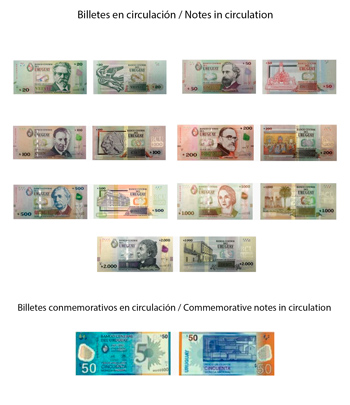Uruguayan Peso exchange rate
WE SELL RATE HISTORY OF URUGUAYAN PESO
WE BUY RATE HISTORY OF URUGUAYAN PESO
URUGUAYAN PESO INFO
The Uruguayan Peso is the official currency of Uruguay.
Notes: 20, 50, 100, 200, 500, 1000 and 2000 Pesos
Coins: 1, 2, 5 and 10 Pesos
Subunit: cent
Code: UYU
Symbol: $, UYU
Main Exchanges
If you are going to travel to Montevideo, Paysandú or any other city in Uruguay you will need to change your Euros into Uruguayan Pesos. At Eurochange you can buy Pesos at the best price and with immediate availability. Buy them now online or find your nearest office with currency sale service.
About the Uruguayan Peso
The Uruguayan Peso is the official currency of the Oriental Republic of Uruguay. Its ISO 4217 code is UYU and its symbol is $. The Peso is divided into 100 cents.
History of the Uruguayan Currency
Since Uruguay's declaration of independence in 1825, there have been several different currencies, but the first one that is considered totally Uruguayan was the one created in 1840, which had coins of 5 and 20 hundredths of a Real. In 1844, the Peso Fuerte was minted. It was the only silver coin minted in Uruguayan territory and it was popularly known as "Peso del Sitio", as it was only valid in Sitio, Montevideo. In the following years, banks started to issue their own banknotes, so there would be several different types of currency. In 1865, a new law forced banks to back up their banknote issues with gold. In 1896, the Bank of the Republic was created, which in 1907 would become the only entity authorized to issue banknotes until 1967, when the Central Bank of Uruguay was created.
In the 1960s, the Uruguayan currency suffered a great devaluation, so in 1975 the official currency was changed to the Nuevo Peso, with which 1000 pesos would be equivalent to 1 Nuevo Peso. This currency was in effect until 1993, when it was changed back to the Peso as the devaluation continued to increase. 1000 Nuevos Pesos became the equivalent of 1 Peso.
Uruguayan Peso banknotes and coins
The Uruguayan Peso notes are 20, 50, 100, 200, 500, 1000 and 2000 Pesos. The banknotes currently in circulation are those issued since 1994. There are several series in legal tender of each of the denominations.
The 20 Pesos notes are green and on the front we can see the image of Juan Zorrilla de San Martín, writer, journalist, teacher and diplomat, born in Montevideo and who represents a very important figure for the country. On the obverse we find the Allegory of the Homeland Legend, a poem by the author.
On the 50 banknotes, where the color red predominates, we see the effigy of José Pedro Varela, an Uruguayan writer, journalist and politician who passed the Common Education Law that established free and compulsory secular school education. On the back we see the monument that was built in his honor in Montevideo, his hometown.
There is also a 50 Peso note commemorating the 50th anniversary of the Central Bank of Uruguay. It is made of polymer and it is blue in color. On its front we can see the nation's coat of arms, the map of Uruguay and the logo of the anniversary of this institution. On the back we see the artwork "Mural: Port Construction".
On the front of the 100-peso note we see Eduardo Fabini, an Uruguayan musician and composer. These notes are violet in color and on the back you can see a musical allegory of his work.
The 200 notes have an ochre tone. On the obverse is a representation of one of the most important painters of Latin America, Pedro Figari. On the back we can see one of his most famous works known as "Dancing People".
The 500 Pesos banknote is blue and it shows the effigy of Alfredo Vazquez Acevedo, Uruguayan lawyer and politician who founded the Common Education Law with Jose Pedro Varela, among others. On the back we see the drawing of the University of the Republic, the largest and most important public university in the country.
The 1000 bills are a yellowish green tone. On the front we find the only female figure that we can see in the Uruguayan Pesos, that of Juana de Ibarbourou, Uruguayan poetess and one of the most relevant people in Spanish-American lyric of the beginning of the 20th century. On the back La Palma de Juana is represented, a palm tree that belonged to the poet.
Finally, the 2000 Uruguayan Pesos notes are grey and they show the image of Dámaso Antonio Larrañaga, one of the main people responsible for the foundation of the National Library and the creation of the University of the Republic. On the back of these banknotes we can see an illustration of the National Library of the Republic of Uruguay.
The coins of Uruguayan Pesos are of 1, 2, 5 and 10 Pesos. In all of them we can see the effigy of General José Artigas, a relevant military man in the War of Independence of the United Provinces of the Río de la Plata.
How many Pesos should I take with me on my trip to Uruguay?
If you are preparing your trip to Uruguay and have doubts about how much money to take with you, we can help you. Our clients usually take 360 Euros in Uruguayan Pesos. To calculate approximately how much money you will need for your trip you should take into account whether, once you arrive at your destination, you have to pay for hotels, rental cars, excursions, tickets, etc. or if you will only have day-to-day expenses such as food, public transport or shopping.
Look for the closest office with this currency



